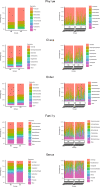Alterations in the intestinal microbiome and mental health status of workers in an underground tunnel environment
- PMID: 33407119
- PMCID: PMC7788853
- DOI: 10.1186/s12866-020-02056-3
Alterations in the intestinal microbiome and mental health status of workers in an underground tunnel environment
Abstract
Background: Working in an underground tunnel environment is unavoidable in professions such as miners and tunnel workers, and there is a concern about the health of these workers. Few studies have addressed alterations in the intestinal microbiome of workers within that environment.
Results: Fecal samples were collected from the workers before they entered the tunnel (baseline status, BS) and after they left the tunnel (exposed status, ES), respectively (a time period of 3 weeks between them). We analyzed 16S rRNA sequencing to show the changes in microbial composition and self-evaluation of mental health questionnaire was also performed. The results showed that Shannon and Simpson indices decreased significantly from BS to ES. A higher abundance was found in the phylum Actinobacteria, classes Actinobacteria and Deltaproteobacteria, orders Bifidobacteriales, Coriobacteriales, and Desulfovibrionales, families Bifidobacteriaceae, Peptostreptococcaceae, Coriobacteriaceae, Clostridiaceae_1, Desulfovibrionaceae, Pseudomonadaceae, and Microbacteriaceae, and genera Bifidobacterium, Romboutsia, Clostridium sensu stricto, and Leucobacter in ES, while BS showed greater levels of genera Faecalibacterium and Roseburia. The self-evaluation showed that at least one-half of the tunnel workers experienced one or more symptoms of mental distress (inattention, sleeplessness, loss of appetite, headache or dizziness, irritability) after working in the underground tunnel environment.
Conclusions: Collectively, the underground tunnel environment led to alterations in the intestinal microbiome, which might be relevant to symptoms of mental distress in underground-tunnel workers.
Keywords: 16S rRNA; Brain-gut-microbiota axis; Gut microbiome; Mental distress; Underground tunnel environment.
Conflict of interest statement
The authors declare that they have no competing interests.
Figures




References
-
- Li F, Xiao M, Zhang J, Yang J, Zhu L. Health risk assessment on tunnel workers’ exposure to PM10 based on triangular fuzzy numbers. AIP Conf Proc. 2017;1820:040011. 10.1063/1.4977283.
Publication types
MeSH terms
Substances
Grants and funding
LinkOut - more resources
Full Text Sources
Other Literature Sources
Medical

